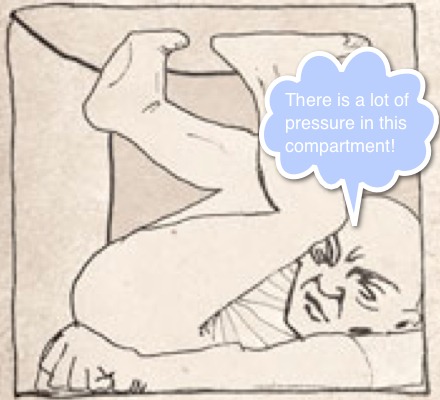Compartment Syndrome
Happy New Year!
Being as this is the 4th calendar year of the Ped EM Morsels, let’s deal with a significant medical emergency that can be tricky to diagnose, but devastating when missed: Compartment Syndrome.
Compartment Syndrome Basics
- Condition where elevated compartmental pressures can compromise perfusion and lead to muscle and nerve damage.
- May occur in any area that skeletal muscle is surrounded by fascia.
- Common causes:
- Trauma (fractures, crush, etc)
- Restrictive / Constrictive external wrappings (casts, dressings, etc)
- Burns
- Vascular Injury
- Bleeding disorders
- Extravastation of infused medications or fluids
- It is important to keep in mind that compartment syndrome can be iatrogenic and does not need to be associated with trauma!
- Volkmann’s Ischemic Contracture is most commonly due to neglected compartment syndrome.
The 5 P’s of Compartment Syndrome
Traditionally, we are all taught that Compartment Syndrome is a clinical diagnosis (which is true) and that it can be diagnosed by the presence of the “5 P’s”… well, that may be part of the story.
- Pain Increasing
- Often Pain with passive extension is the most sensitive finding
- Disproportionate pain at rest or with passive stretch warrants close monitoring!
- Pain may disappear late in the course of the condition, as the area has severe nerve impairment.
- KEEP THIS ONE IN MIND
- Paresthesias
- Would indicate that the nerves are being affected.
- If condition progresses, anesthesia will occur.
- Poikilothermia
- Difference in the injured area’s warmth compared to the contralateral location.
- If the affected area feels cooler than the unaffected area, then this would suggest that the area cannot thermoregulate and has vascular compromise.
- Paralysis
- Late finding… if you have this, outcome will be poor.
- Pallor and Pulselessness
- Late finding… and also portends poor outcome.
- Having a pulse is good, but it does not mean that the pressures are not significant enough to cause damage.
As you can see, many of these findings are present late in the course of the condition, and potentially ominous signs. The presence of significant swelling and increasing pain needs to cause the synapses that make us consider Compartment Syndrome to fire.
Additionally, certain patients require more vigilance (Mabvuure, 2012).
- Patients with tibial diaphysis fractures (especially young men)
- Patients with high-energy injury to Forearm diaphysis or distal radius
- Patients with high-energy fractures of the tibial metaphysis
- Young men with soft tissue injury or those with Bleeding Disorders.
- CHILDREN
- Drug user
Compartment Syndrome in Children – a little bit trickier
We are all aware that communication can be a little difficult with children and this can make the diagnosis more difficult and lead to delays.
- Kids may be reluctant to be examined – either fear more pain or just fear your funny looking face.
- Kids may not understand how to describe the altered sensation that they have … even older teenagers might not be able to convey “parethesias.”
It has been demonstrated that the diagnosis and definitive therapy (fasciotomy) is often delayed in children (mean time was 27.9 hours – problem when nerve damage can occur within 12 hours). So to help improve diagnosis, think less about the “5 P’s” and instead use the “3 A’s.”
3 A’s of Compartment Syndrome
-
Anxiety, increasing
-
Agitation
-
Analgesics
-
The increased need for analgesics preceded the classic presentation by several hours
-
It is important to realize that Compartment Syndrome is a dynamic process and potentially evolving as you are evaluating the patient. Serial examinations is paramount. The goal is to detect the condition before it progresses to the state of having all 5 P’s and, thus, improve outcome.
Mabvuure NT, Malahias M, Hindocha S, Khan W, Juma A. Acute Compartment Syndrome of the Limbs: Current Concepts and Management. Open Orthop J. 2012; 6: 535-543. Noonan K, McCarthy JJ. Compartment Syndromes in the Pediatric Patient. Journal of Pediatric Orthopaedics. 2010; 30: S96-S101.



[…] 14) http://pedemmorsels.com/compartment-syndrome/ […]
[…] this and make sure you don’t miss the devastating condition of Compartment Syndrome – remember the 5 P’s to stay safe, remember the 6th P […]